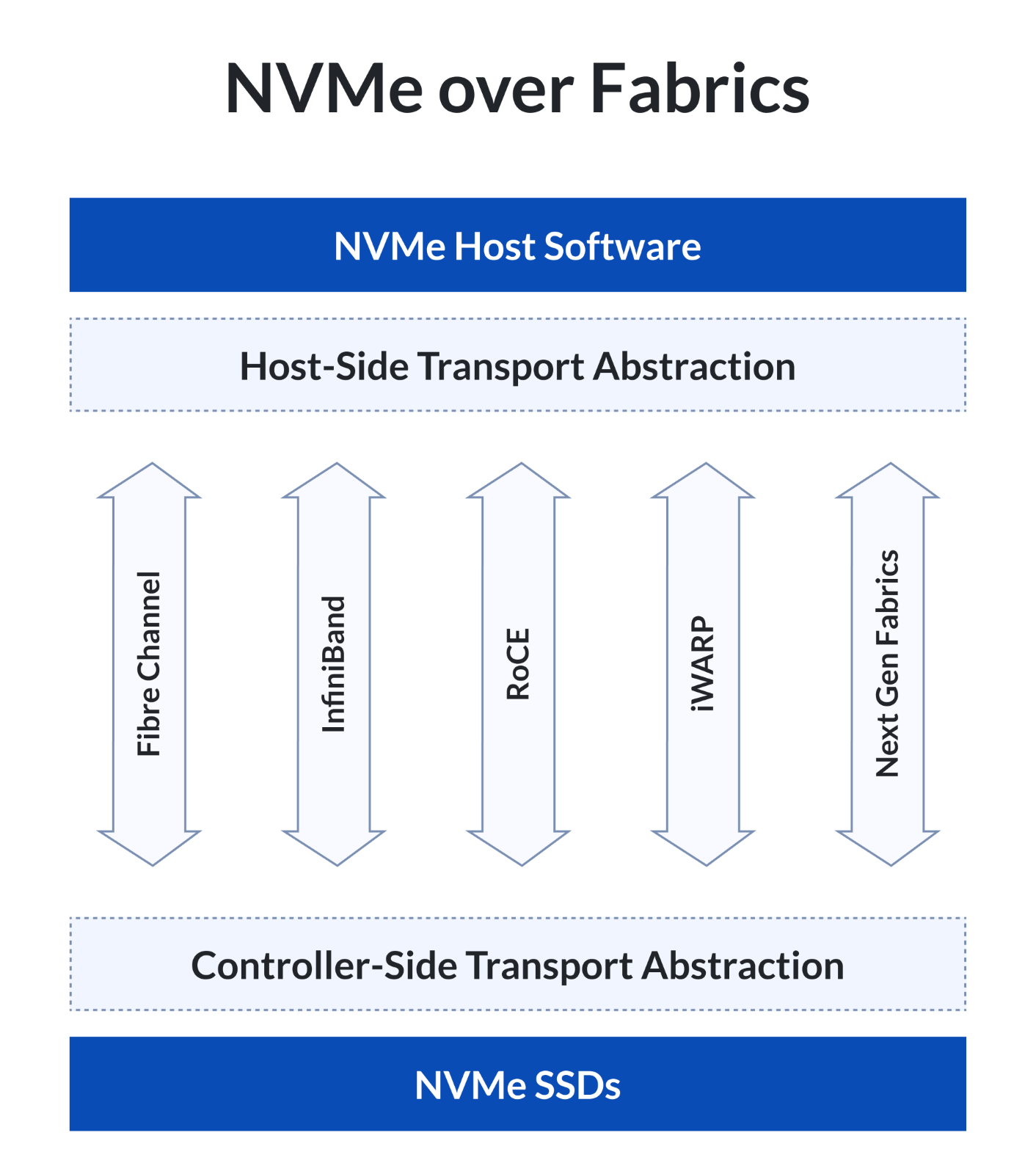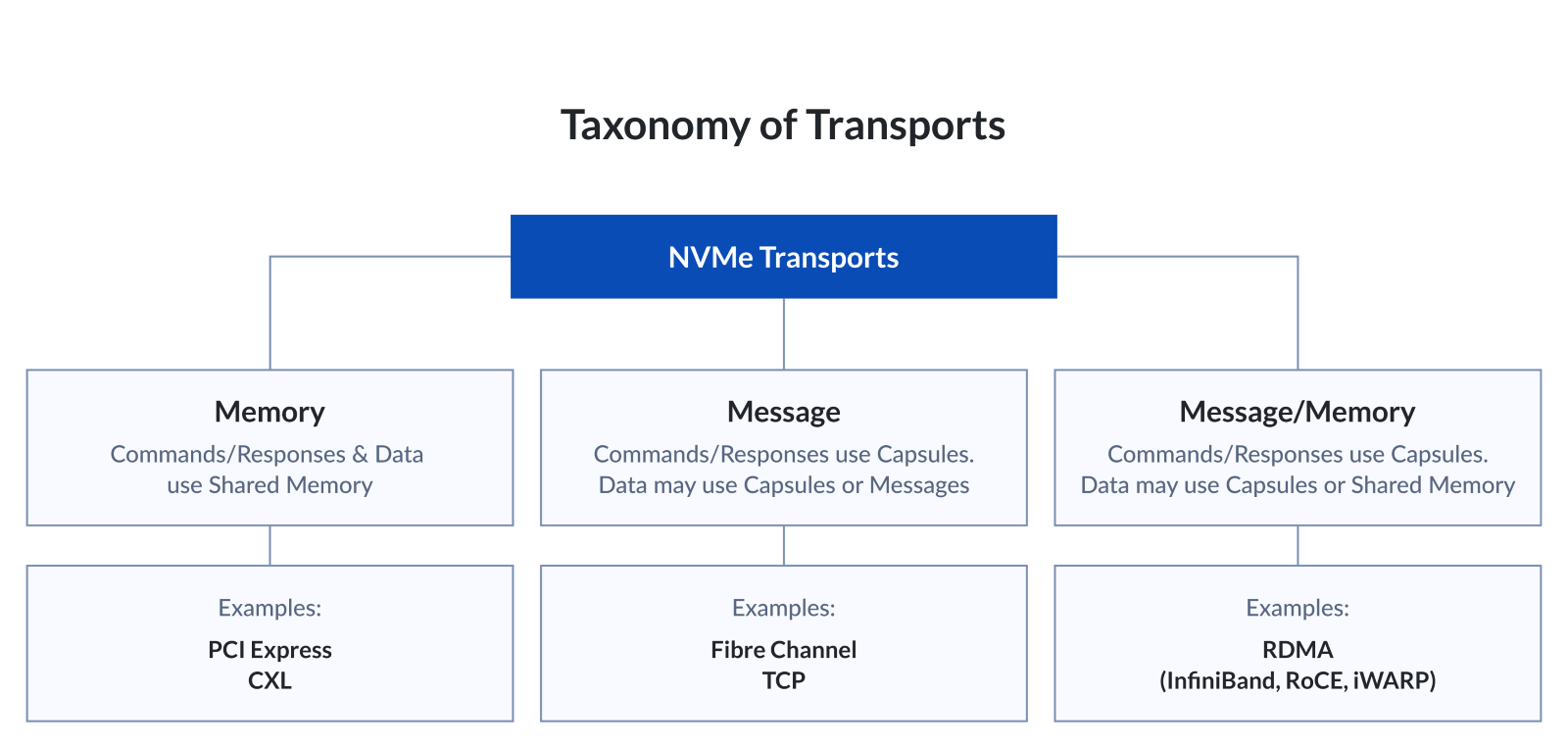The world of data storage is constantly evolving, and the emergence of NVMe over Fabrics is one of the most significant advancements in the past decade. NVMe over Fabrics (also known as NVMe-oF or Non-Volatile Memory Express over Fabrics) is a protocol specification that extends the capabilities of NVMe storage to networked environments. It enables high-speed, low-latency communication between hosts and remote storage devices over various network fabrics, such as Ethernet, Fibre Channel, and RDMA (InfiniBand, RoCE, iWARP).
NVMe-oF emerged as a pivotal development in the data storage landscape in the mid-2010s. In 2011, the NVMe specification was introduced, optimizing flash storage through direct PCIe attachment. However, only in 2016, the NVMe-oF specification was originally published as a standalone document, introducing the concept of extending the speed and efficiency of NVMe storage to networked environments.
This technology has been persistently evolving, and its adoption within the IT industry is expanding rapidly. Many network vendors are now introducing NVMe-oF-related products to the enterprise market, reflecting the growing importance of this technology in modern data centers. In this article, we’ll explore what NVMe-oF is, its benefits, use cases, and how it compares to traditional NVMe storage. We’ll also delve into the different transport options for NVMe-oF and discuss why StarWind is a top choice for implementing this technology.

Benefits of NVMe-oF
NVMe over Fabrics (NVMe-oF) introduces a range of compelling benefits that significantly enhance data storage and application performance. Some of the key advantages include:
- Ultra-Low Latency: NVMe-oF dramatically reduces data access latency, ensuring that applications and servers can fetch and process data with minimal delay. This is especially crucial for real-time, high-performance workloads.
- Additional Parallel Requests: With NVMe-oF, hosts can simultaneously send multiple data requests, allowing for concurrent data transfers and processing. This parallelism boosts overall data throughput.
- Scalability: The architecture of NVMe-oF allows for easy scalability. As organizations grow and their storage needs increase, they can seamlessly add more NVMe-oF-capable devices to their infrastructure.
- Increased Overall Performance: The protocol’s low latency and high-speed capabilities result in enhanced overall system performance, making it ideal for data-intensive applications.
- Reduction of OS Storage Stacks: NVMe-oF streamlines storage stack operations on the server side, reducing the length of the data retrieval and processing path. This optimization enhances the overall efficiency of data handling.
- Improvements to Storage Array Performance: NVMe-oF’s efficiency and speed improvements extend to storage arrays, ensuring that data storage systems perform at their peak.
- Faster Transition to NVMe SSDs: NVMe-oF facilitates a faster transition from traditional Serial-Attached SCSI (SAS) or Serial Advanced Technology Attachment (SATA) drives to NVMe SSDs, enabling organizations to benefit from faster storage solutions.
- Variety of Implementation Types: NVMe-oF offers a variety of implementation options, accommodating different scenarios and use cases, from real-time analytics to cloud services. This adaptability ensures that the protocol can meet the specific needs of your organization, regardless of the application or workload.
- Lower TCO (Total Cost of Ownership): While NVMe SSDs tend to be more expensive than traditional HDDs, NVMe-oF can help reduce the total cost of ownership by optimizing hardware utilization (less overhead = more performance).
- Future-Proofing: As the demand for high-performance storage continues to grow, NVMe-oF positions organizations to meet future data processing requirements without the need for a complete infrastructure overhaul.
NVMe over Fabrics empowers organizations with low-latency, high-speed connectivity, efficient data handling, and the ability to consolidate diverse applications on shared networked storage. It not only matches the performance of direct-attached storage but also outperforms traditional storage protocols, resulting in more efficient and parallel data processing and data center consolidation.
NVMe-oF Use Cases
NVMe-oF finds applications across various industries and use cases. Some notable scenarios where NVMe-oF can be a game-changer include:
- Databases and Analytics: NVMe-oF’s low latency and high throughput capabilities make it ideal for database and analytics workloads, where rapid data access is critical for performance.
- Virtualization: Virtualized environments benefit from the improved storage performance offered by NVMe-oF, resulting in faster VM provisioning and reduced latency for virtualized applications.
- Artificial Intelligence (AI) and Machine Learning (ML): AI and ML workloads often involve massive datasets that require rapid access. NVMe-oF accelerates data access, helping data scientists achieve faster insights.
- Cloud Service Providers: Cloud providers can leverage NVMe-oF to deliver high-performance storage services to their clients. The protocol’s low latency and scalability enable cloud infrastructure to meet the needs of diverse workloads efficiently.
- High-Performance Computing (HPC): NVMe-oF is a natural fit for HPC environments, where data access speed and parallel processing are paramount. It accelerates data storage, analysis, and simulations in scientific and research applications.
- Media and Entertainment: Video editing, rendering, and content creation workflows benefit from NVMe-oF’s high throughput, allowing for faster content production and rendering.
- Telecommunications: In the telecommunications sector, NVMe-oF enhances the speed and responsiveness of applications, including signal processing, real-time analytics, and network management.
- Financial Services: In the finance sector, low-latency access to data is critical for algorithmic trading and real-time risk analysis, making NVMe-oF a valuable asset.
- Healthcare and Life Sciences: NVMe-oF accelerates data access for medical imaging, genomics, and bioinformatics applications, contributing to quicker diagnoses and advancements in healthcare and life sciences research.
- Oil and Gas Exploration: NVMe-oF improves the performance of data analysis tools in the oil and gas industry. It speeds up seismic data processing and enhances decision-making in exploration and drilling activities.
These diverse use cases demonstrate the versatility and transformative potential of NVMe-oF. Its ability to deliver high-speed, low-latency storage solutions makes it a valuable asset in industries where data access speed and efficiency are critical for success.
NVMe over Fabrics vs. NVMe
To appreciate the significance of NVMe-oF, it’s essential to understand how it differs from the traditional NVMe protocol. Here are the key differentiators:
- Direct vs. Remote Access: NVMe is designed for direct-attached storage, offering high-speed access to local SSDs. In contrast, NVMe-oF extends NVMe’s capabilities to remote storage devices, accessible over network fabrics.
- Transport Protocol: NVMe relies on the PCIe bus for communication, while NVMe-oF leverages various fabric transports such as Ethernet, Fibre Channel, and TCP/IP.
- Scalability: NVMe is typically limited to a single host, while NVMe-oF allows multiple hosts to access shared NVMe storage resources, enhancing scalability.
- Use Cases: NVMe is suitable for high-performance local storage, while NVMe-oF is ideal for scenarios requiring remote storage access, particularly in data centers and cloud environments.
- Management and Centralization: NVMe-oF centralizes storage resources, simplifying management, and reducing complexity compared to managing numerous NVMe devices across multiple hosts.
Understanding these distinctions helps organizations determine when to deploy traditional NVMe and when NVMe-oF is the better fit for their storage needs.
NVMe-oF Transports
NVMe-oF supports several transport options, each with its own characteristics and advantages.

Let’s explore these transport protocols in more detail:
1. NVMe-oF over RDMA
NVMe-oF over Remote Direct Memory Access (RDMA) is a high-performance transport option that minimizes CPU overhead and delivers extremely low latency. RDMA allows for efficient data transfer between hosts and storage devices, making it well-suited for demanding workloads. It utilizes RDMA protocols, such as RDMA over Converged Ethernet and the Internet Wide Area RDMA Protocol for Ethernet and InfiniBand.
Memory-to-Memory Transport: RDMA facilitates direct data transfer between two computers, bypassing the operating system or processor. This results in minimal overhead and exceptionally fast access and response times, often in microseconds.
Common Language with NVMe: NVMe serves as the protocol for moving storage traffic across RDMA over Fabrics, providing a common language for efficient communication between compute servers and storage devices.
High Performance: Implementing NVMe-oF with RDMA enhances storage network performance. However, it comes with slightly reduced scalability compared to the Fibre Channel (FC) protocol.
2. NVMe over Fibre Channel
NVMe over Fibre Channel (FC) combines the speed and reliability of Fibre Channel with the performance benefits of NVMe. This transport is often used in enterprise environments that require robust and dedicated storage networking. FC-NVMe enables the mapping of various protocols, including NVMe, SCSI, and IBM’s proprietary Fibre Connection, to transmit data and commands between host and target storage devices.
Coexistence with Legacy FC: FC-NVMe can coexist with Gen 5, 6, or 7 FC in the same infrastructure, allowing data centers to avoid disruptive upgrades.
Firmware-Based Upgrade: Organizations can upgrade existing FC network switches using firmware, provided the host bus adapters support 16 gigabits per second or 32 Gbps FC and NVMe-oF-capable storage targets.
Backward Compatibility: The FC protocol supports access to shared NVMe flash. While
there’s a performance impact due to the interpretation and translation of encapsulated SCSI commands to NVMe commands, the Fibre Channel Industry Association is actively working on standards for backward-compatible FC-NVMe implementations. This enables a single FC-NVMe adapter to support SCSI-based disks, traditional SSDs, and PCIe-connected NVMe flash cards.
3. NVMe over TCP/IP
NVMe over TCP/IP extends NVMe storage access over standard Ethernet networks. It offers a cost-effective solution for organizations looking to leverage their existing Ethernet infrastructure for NVMe-oF deployments.
Utilizing Ethernet Networks: NVMe over TCP/IP facilitates the use of NVMe-oF across a standard Ethernet network, eliminating the challenges often associated with implementing additional equipment and configurations.
Widely Accepted Standard: TCP/IP is widely accepted as a standard for establishing and maintaining network communications, making it an excellent choice for data exchange across networks.
IP Network Support: The TCP binding defines how data between a host and a non-volatile memory subsystem are encapsulated and delivered. It also outlines how queues, capsules, and data are mapped to support TCP communications between NVMe-oF hosts and controllers through IP networks.
Additionally, there are specific newest configurations like NVMe over RDMA over Converged Ethernet (RoCE) and NVMe-oF over RoCE support for VMware. These transport methods provide organizations with a range of options to suit their specific requirements and infrastructure. They may be considered optional based on specific use cases.
Why choose StarWind for NVMe-oF?
StarWind stands out as a pragmatic choice for implementing NVMe-oF storage infrastructure. Why? First and foremost, StarWind is constantly investing in the development of NVMe-oF-ready solutions, helping to bring about its mass adoption. For example, StarWind NVMe-oF Initiator is currently the only production-ready solution of this kind for Microsoft Windows OS.
Moreover, StarWind is among the first vendors now rolling out active-active high availability (HA) NVMe-oF storage solutions. What’s more, StarWind is not only packaging the technology in the form of hardware appliances but also making it available as a software-only solution (SDS) – StarWind Virtual SAN (VSAN). I recommend subscribing to StarWind’s Twitter to not miss this major NVMe-oF HA update.
Conclusion
In conclusion, NVMe over Fabrics (NVMe-oF) represents a significant advancement in storage technology, enabling organizations to harness the exceptional performance of NVMe SSDs over fabric networks. With benefits ranging from enhanced performance and scalability to reduced total cost of ownership, NVMe-oF has found applications in a wide range of industries.
Understanding the differences between NVMe and NVMe-oF is crucial for selecting the right storage solution for specific use cases. NVMe-oF supports various fabric transports, including RDMA, Fibre Channel, and TCP/IP, each catering to different performance and infrastructure requirements.
When considering NVMe-oF deployments, organizations can benefit from the expertise and solutions offered by providers like StarWind, which offer a seamless, high-performance, and scalable approach to NVMe-oF storage.
As data-intensive workloads continue to evolve, NVMe-oF is poised to play a central role in modernizing storage infrastructure, enabling organizations to meet the demands of today’s dynamic digital landscape.
This material has been prepared in collaboration with Iryna Chaplya, Technical Writer with almost 5 years of experience at StarWind.

